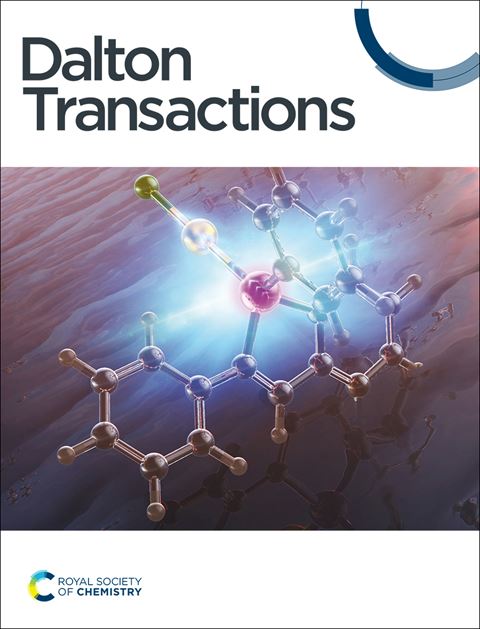乙酰丙酮作为金属卟啉的轴向配体:第一晶体结构、配位化学及作为高效光敏剂的潜在应用
IF 3.5
3区 化学
Q2 CHEMISTRY, INORGANIC & NUCLEAR
引用次数: 0
摘要
乙酰丙酮是一种二酮,是一种非常常见的双齿配体,很早就在化学实验课上用于教授不同类型金属配位化合物的合成。它是一种多用途的有机化合物,已知以它为基的大量配位化合物和杂环化合物。本研究首次证明了乙酰丙酮配位金属卟啉的单晶结构,[MgT(4-Cl)PP(Hacac)], 1 [T(4-Cl)PP= 5,10,15,20-四(4-氯苯)卟啉,Hacac=乙酰丙酮。化合物1通过紫外可见、红外、核磁共振、质谱以及单晶和粉末XRD进行了表征。化合物1是五配位的,通过更稳定的烯醇形式的酮氧原子轴向连接乙酰丙酮分子。用循环伏安法研究了1的氧化还原性质。利用荧光发射光谱分析研究了其光物理性质。所合成的卟啉化合物具有良好的光稳定性和单线态产氧能力。以化合物1为光敏剂,降解亚甲基蓝(MB)和结晶紫(CV)两种常见的水污染物。在非均相条件下利用阳光在水中进行了研究,发现1在MB和CV染料的光降解中有效,符合准一级动力学,分别在20和15分钟后MB和CV染料降解100%。清除剂存在下的猝灭实验证实了单重态氧降解机理。FTIR光谱分析证实了在光催化降解过程中由于键断裂导致染料和多种反应中间体的降解,质谱分析也证实了这一点。此外,从光稳定性实验中发现,化合物1可以使用6个循环而没有明显的活性损失。通过几何优化、前沿分子轨道能量、电子能谱模拟、分子静电势(MEP)分析等理论计算来支持实验结果。本文章由计算机程序翻译,如有差异,请以英文原文为准。
Acetylacetone as an axial ligand in metalloporphyrin: the first crystal structure, coordination chemistry, and potential application as efficient photosensitizer
Acetylacetone, a diketone, is a very common bidentate ligand and has been used in chemistry laboratory classes for teaching the synthesis of different types of metal coordination compounds long back. It is a versatile organic compound and a large number of coordination and heterocyclic compounds based on it are known. This work demonstrates the first single crystal structure of an acetylacetone-coordinated metalloporphyrin, [MgT(4-Cl)PP(Hacac)], 1 [T(4-Cl)PP= 5,10,15,20-tetrakis(4-chlorophenyl)porphyrin, Hacac= acetylacetone. Compound 1 was characterized by UV-visible, infrared, NMR, and Mass spectroscopy as well as single-crystal and Powder XRD. Compound 1 is penta-coordinated with axial ligation of an acetylacetone molecule via the keto oxygen atom of a more stable enolic form. The redox properties of 1 were studied by cyclic voltammetry. Photophysical properties were investigated by the fluorescence emission spectral analysis. The synthesized porphyrin compounds exhibited good photostability and singlet oxygen generation ability. Compound 1 was used as a photosensitizer for the degradation of two common water contaminants, methylene blue (MB) and crystal violet (CV). Studies were conducted in water under heterogeneous conditions using sunlight, and 1 was found to be efficient in the photodegradation of MB and CV dyes, following pseudo-first-order kinetics with 100% degradation of MB and CV dye after 20 and 15 minutes, respectively. Quenching experiments in the presence of scavengers confirmed the mechanism of degradation via singlet oxygen. FTIR spectral analyses verified the degradation of dyes and the multiple reaction intermediates due to the breaking of the bonds during the photocatalytic degradation process, which was confirmed by mass spectral analyses. Moreover, from the photostability experiment, it was found that compound 1 could be used up to 6 cycles without appreciable activity loss. Theoretical calculations like optimization of geometry, the energy of frontier molecular orbitals, simulation of electronic spectra, and molecular electrostatic potential (MEP) analysis were performed to support the experimental results.
求助全文
通过发布文献求助,成功后即可免费获取论文全文。
去求助
来源期刊

Dalton Transactions
化学-无机化学与核化学
CiteScore
6.60
自引率
7.50%
发文量
1832
审稿时长
1.5 months
期刊介绍:
Dalton Transactions is a journal for all areas of inorganic chemistry, which encompasses the organometallic, bioinorganic and materials chemistry of the elements, with applications including synthesis, catalysis, energy conversion/storage, electrical devices and medicine. Dalton Transactions welcomes high-quality, original submissions in all of these areas and more, where the advancement of knowledge in inorganic chemistry is significant.
 求助内容:
求助内容: 应助结果提醒方式:
应助结果提醒方式:


